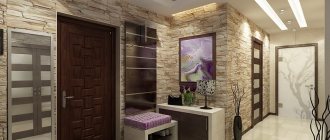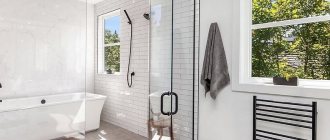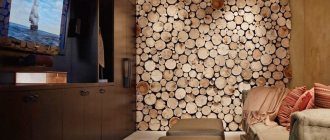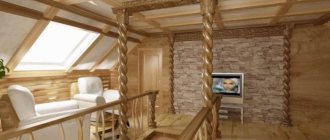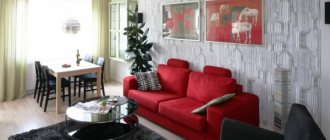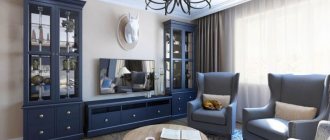A modern dressing room should not only be multifunctional and convenient for storing the required amount of clothes and shoes, but it should also in its own way reflect the general concept of furnishing the home where it is located. It is necessary that a modern dressing room fits perfectly into the overall interior of a house or apartment, and it is most advantageous in this regard to use the original color scheme of the walls and cabinets in this room.
Wardrobe room - making a project
As you can see, there are a lot of ideas for warehouse equipment and systems. But so that it doesn’t turn out that the great thing you bought simply doesn’t end up in your wardrobe, you need to draw a plane on which you indicate all the sizes and dimensions. It is drawn to scale, so mark on it the details you need to request. They are drawn to the same scale.
If everything “goes well”, armed with the dimensions (you have them, or you can measure according to the figure and calculate the real values on a scale), you can go to the store to select systems.
There is another approach. Find out the dimensions of the devices and systems you like (installation dimensions), cut them out to scale from cardboard or thick paper and try to combine everything. If you can, you can buy. No, look for other options. As a result of your efforts, you should end up with approximately the same layout as in the photo.
An example of organizing space in a dressing room (indicating the minimum sizes for different types of clothing)
To make it convenient to use equipment and get things out, you need to maintain the following distances:
- minimum distance from shelf to shelf: when storing things - 30 cm; when storing shoes (without stilettos) - 20 cm;
- shirts, jackets, jackets - 120 cm;
- trousers: folded in half - 100 cm; length - 140 cm;
- compartment for outerwear - 120 cm; coat - 160-180 cm;
- for dresses - 150-180 cm.
On top we reserve space for clothes from another season or rarely used items. There is often space for a vacuum cleaner downstairs, and one of the cabinets has a built-in ironing board.
Selecting functional add-ons
In addition to the basic equipment, the wardrobe is complemented by other auxiliary items.
- Ironing board. When folded, the ironing board remains completely invisible, since it is usually hidden in a niche or narrow cabinet in one of the sections of the dressing room. For such an additional element, you need to think about the location of the outlet, and choose a place where you can place the iron, taking into account safety rules.
- Mirror in the dressing room. The dressing room space can be equipped with several mirrors, providing views from different angles, or you can install one mirror sheet that reflects the silhouette in full height. A very convenient option are huge cabinets with a mirrored facade.
- Dressing room with dressing table. A dressing table with all the attached attributes will make it easier to create an image. Since, thanks to this element, it is possible to combine the application of cosmetics, fitting of outfits and jewelry in one place.
- Dressing room with sofa. A soft sofa not only serves as a relaxation area, but also provides a comfortable place to place things, combine clothes and create suitable ensembles.
- Organizers for small items. Thanks to additional organizers, organized storage of small items is created. Jewelry, various decorations, belts, ties, etc. will always be at hand.
The photo shows the design of a separate wardrobe with a dressing table.
In order to easily get the necessary things from the upper tier, a folding stepladder is installed in the wardrobe. In a small dressing room, the stairs can be replaced with a regular stool or chair.
How to make a dressing room: placement options
In a house, a storage room is also assigned at the design stage or later when allocating rooms. They are rarely found in standard apartments. Therefore, we need to find a suitable solution. Let's look at several possible options for what and where you can make a dressing room with your own hands.
In the hall
It would be good if the owner had a large room at his disposal, part of which could be taken out to organize a storage system for things. In this case, a partition is placed dividing the corridor into two rooms. The size and shape of the wardrobe is chosen according to your preferences.
In small apartments there are two solutions for how to make a dressing room in the hallway. The first is intended for long but rather wide rooms. There is a file cabinet on one of the walls. It is optimal to choose a closed wardrobe, possibly with mirrored doors. This will visually expand a small space. The second option is for square or cramped layouts. In this case, the corner is fenced off with a partition, and a storage system is installed inside it.
In the bedroom
It is customary to store clothes in the bedroom, so this solution is considered very appropriate. The space for the storage system is determined based on the shape of the bedroom. If it is too stretched, it is best to fence off the area across the room. The bedroom will acquire the correct proportions, become more comfortable and attractive. In fairly spacious, square and adjacent rooms, a corner placement of the dressing room is preferable. It is separated by a permanent partition with doors or a thick curtain.
Under the stairs
The free space under the flight of stairs is deep enough to accommodate a storage room. There are many options for arrangement. You can make an open cabinet or with doors: sliding or hinged. A modular design, which is assembled from retractable or retractable elements, is also suitable. Inside such blocks there are hooks, crossbars, shelves, and drawers.
Out of the closet
A boring wardrobe can easily be converted into a wardrobe if desired. The layout depends on the available space. The filling is pulled out of the old cabinet, leaving only the frame, which will become the basis of the new design. It is installed in place and the filling is installed. You can do things differently. Use old furniture as closet storage. Take some elements without changes, change them and repeat something.
From a niche
If the size of the niche allows, shelves and shelves are arranged inside. All that remains is to install the doors: hinged, sliding or compartment. The cabinet can be left open, but it should look attractive and neat, or covered with a thick fabric curtain. Small niches are complemented by a plasterboard structure, which expands to the desired size.
In the pantry
Older apartments often have a small, windowless room called a closet. Usually its area allows you to place a full-fledged dressing room in the interior. The filling can be anything, placed along the walls or the letter G. The door is closed with a curtain or a suitable door is installed.
Behind the partition
You can arrange the closet behind the partition yourself, without involving specialists. The partition can be improvised or stationary.
Homemade partition for a wardrobe.
Improvisation - using thick curtains to separate a room. The curtain is attached to the ceiling with a cornice or rod. The screen is suitable for a bedroom; behind it you can not only set up a dressing room, but also store bed linen, and, in good lighting, set up a boudoir with a mirror. But a model with a curtain will hardly look appropriate in the living room.
The second option is zoning with a plasterboard wall, this model is a little more complicated and expensive, but there are no problems with the location, it can be installed in any room. No permits will be required to construct such a building. This structure can be dismantled at any time.
Types of dressing rooms
There are two main types of locker rooms:
- Open
- Locked
Let's take a closer look at each type.
Open dressing room
An open dressing room suggests that the pantry is not separated by partitions or doors, but is a continuation of the interior.
Advantages of an open dressing room:
- Everything is in sight and within reach
- Convenient to arrange in small apartments
- The space of the room remains visually spacious
Disadvantages of an open dressing room:
- Everything is visible, including to your guests
- Items must be kept in perfect order to maintain the aesthetic appearance of the room.
Closed dressing room
A closed dressing room is located in a separate room or niche, which is fenced off with a screen or compartment door.
Advantages of a closed dressing room:
- The total area of the apartment is not cluttered with things, clothes, clothes, accessories.
- If there is no opportunity or time to clean up, none of the guests will notice from behind the door.
- A large and spacious walk-in closet can provide storage space for everyone in the family, no matter how big it is.
- There is a lot of storage space, which can be organized as ergonomically as possible.
- You can try on clothes, put them in order, iron them and get ready at any time of the day without disturbing the house (which is especially important if there is a small child in the house).
If you equip the dressing room with a large mirror or dressing table, then the dressing room will serve not only as a storage room, but also as a full-fledged dressing room.
Disadvantages of a closed dressing room:
- You need the place because of its location
- additional lighting required
- A living room with a closed dressing room becomes visually and functionally smaller
Proper lighting
For this room you need to choose lighting as close to daylight as possible. Installing halogen or diode lamps that do not distort colors will help with this.
It is appropriate to equip a small dressing room with compact light bulbs or built-in lamps, which can be located in any area of the room. In the wardrobe, you should consider multi-level lighting with LED strips, track lamps and sconces.
The photo shows a dark dressing room equipped with LED lighting.
Where to arrange a dressing room?
In a private house
In a private house, when creating your own design project, you can specifically provide a dressing room. It is best if it is in close proximity to the owner's bedroom or, if the family is large, in a place where any family member can easily (and without disturbing others!) enter.
If a special room is not provided, the dressing room can accommodate:
- Under the stairs
- In the large corridor
- Behind the bed
- In the attic
In the apartment
The likelihood that your apartment (especially in a Khrushchev-era building) will have a separate dressing room is even less than in a private house. Therefore, if the apartment area is not enough and you really want a dressing room, you should think about its location:
- In the pantry
- In a niche
- In the fenced part of the room
In an apartment, the dressing room can be separated from the living area of the room with a screen, curtain or doorways.
Wardrobe room layout
Depending on the area, the location of door and window openings, the number of things and the preferences of the owners, the arrangement of the dressing room can be done in different ways. Each of the presented options has certain characteristics that make it suitable for a certain type of room.
Linear layout
It resembles a family wardrobe, with the only difference being that the doors are completely absent or in their place there is a partition from floor to ceiling, and inside there is free space for moving along the shelves. This wardrobe arrangement is ideal for installation in a rectangular room along a blank wall or around a door.
Parallel layout
The optimal solution for rooms with an extended corridor, with a window or a large mirror in front of the door. In this case, shelves and hangers are located on opposite walls so that all things remain in sight and are easy to reach, and the spaciousness of such a dressing room can only be envied.
The presence of a window opening solves the problem of ventilation and daylighting, thanks to which a parallel layout can be recommended when initially designing a dressing room in a drawing of an apartment or house.
U-shaped layout
This is one of the most affordable options for arranging large walk-in closets. For comfortable use of the side walls, the central part must be at least 1.5 m in length.
This room has space for an ironing board, a chair (and sometimes a small sofa) and a mirror, resulting in a convenient dressing room.
Corner layout
It allows you to effectively use space in rooms with limited space: bedrooms, corridors, children's rooms, attics. Placing storage systems at a 90° angle allows you to store twice as much as a conventional linear cabinet.
You can separate the dressing room using sliding doors, both standard and round (semicircular). For high rooms, partitions made of plasterboard or plywood with a door are suitable; curtains and screens come in different types.
Principles of zoning a dressing room
Mandatory zones that a dressing room should have in a house or apartment: - bosses, - middle, - Lower, - place for hats.
The criterion for distributing clothing is the frequency of use.
The upper zone is an alternative to mezzanines; it is placed at least 190 cm. These shelves contain seasonal items that are in demand a couple of times a year. To reach them you will need a ladder.
The central zone is for storing clothes and linen for every day. There is a bar for outerwear, hangers for trousers and ties, and shelves for linen. In the same area, the dressing room design usually includes an ironing board.
The lower part is a place for boots, sandals and shoes. They are stored in special storage boxes and rarely used shoe boxes.
Directly above the central area there is a compartment for hats and caps. Each cell must have a minimum size of 25x18 cm.
Why white?
And not blue or, for example, pink? Because it is the white color that has always been and remains in trend: it can be completely different - strict classic, stylish for youth, and business-appropriate. Pure white and its shades are becoming increasingly popular in wardrobe color schemes offered by various world-famous manufacturers.
Both the visual perception of a person and his psychology are at work here: against the background, for example, of some pastel or brighter colors of the dressing room, many things can lose their attractiveness, can look completely unattractive and for this reason risk waiting for their finest hour on the hanger for a long time.
Some people see in white only facelessness, snowy coldness and neutrality. But when decorating a dressing room, neutrality is exactly what is needed: only in this case the color scheme of clothing items will not be blurred, and all the attention of the dressing room owner will be concentrated exclusively on blouses, blouses, skirts and dresses, as well as shoes and boots to go with them. White color is a powerful means of expression, unobtrusively receding into the background and favorably shading clothes and shoes on hangers and shelves.
Design and organization of a dressing room
The choice of dressing room interior depends on who will use it and what style the entire apartment is designed in.
Women's dressing room
Women's dressing rooms are often decorated in light colors. If space allows, a dressing table and pouf are installed inside. Often a carpet is laid on the floor, and the walls are decorated with paintings.
Most often, the women's dressing room is decorated in a classical style or has elements of Rococo and Baroque. The use of stucco and other decorations is allowed.
Men's dressing room
This is often done in dark colors using wood. Much attention is paid to the functional side: storage of ties, watches and cufflinks, convenient hangers for trousers and dresses.
Children's dressing room
If the children's room is spacious enough, you can separate it into a dressing room. They try to arrange it in such a way that it is convenient for the child to sort out his things and put them in their places.
This dressing room is decorated in light colors, and a lot of attention is paid to the decor, which will turn the cleaning process into an exciting game. For older children, a more discreet design is suitable.
Universal dressing room for the whole family
When planning it, the number of those who will use it is taken into account - everyone should have their own section. Based on the number of things that are planned to be stored here, the number of shelves, racks and space for hooks is calculated.
It is important to analyze your wardrobe and understand what storage compartments each family member will need.
Wardrobe for two
Wooden panels
Wood always remains a noble material with many advantages in use:
- natural, environmentally friendly material;
- durability;
- safety;
- attractive appearance;
- practicality.
The back wall of the dressing room is made of veneer
But experts warn that experienced woodworkers should work with wood, because it is a delicate and “vulnerable” material. One chip and all the beauty is gone. And the cost of such material is very high, so not everyone can afford to decorate walls with wooden panels.
Wooden wardrobe back wall
Dressing room decoration
Once you have removed unnecessary debris from the area where the dressing room will be located, made the right design plan and chosen a style, you can begin to decorate it.
First you need to make ventilation that can pass air into a confined space. Things must be in a well-ventilated place, otherwise they will quickly become unusable. It is also necessary to pay attention to the lighting equipment, because daylight does not penetrate into the dressing room, so it is better to think about bright lighting in advance.
Materials
The dressing room should be functional. As a rule, modules in wardrobe systems are made of wood . A cheaper option may be to make cabinets and drawers from chipboard or MDF.
Hinged doors can be made of plexiglass. In this case, you will always see what is in a particular box.
It is better to choose cellular exhaust baskets made of plastic - they are lightweight, easy to care for and look good.
It is better to choose metal stands for hooks; they are reliable and their appearance does not deteriorate due to constant scratching by hooks.
A small dressing room is best furnished with light-colored furniture.
Walls
You need to start finishing the dressing room from the walls. Use special tools to remove old plaster. Get rid of the wallpaper, as it will not be needed later in the plan. The walls need to be leveled with new materials. If left in the same position, the racks and shelves will most likely not be evenly spaced.
Drywall can be used for precise alignment of walls, as well as PVC panels. With this choice, a corner of the corresponding color is used to connect the ceiling and walls.
Floor
Having previously completed work with the walls, it is necessary to carefully consider the finishing of the floor, since a person will stand for a long time and choose clothes, which means that the floor should be covered with a pleasant and comfortable material. In this case, linoleum or laminate is used, depending on quality and price.
Ceiling
After covering the walls, the ceiling is made to match. If PVC panels were used, it is necessary to cover the top of the room with them so as not to deviate from the style and color of the room. In addition, it is necessary to take into account the color of the furniture and components of the dressing room.
If you have a high ceiling, you can use drywall to make the room look even and tidy.
Storage system
Before installing furniture in the dressing room, you need to prepare it. First of all, it should be dry here, so you need to create ventilation. It is not recommended to create a storage room in a corner of a building that is prone to getting wet and not exposed to sunlight. It is undesirable for it to have a common wall with the kitchen and bathroom. If there are no windows, a fan can be installed for ventilation, which can automatically turn on after a certain amount of time.
It is equally important that the dressing room is protected from the penetration of foreign odors. Bags filled with dried aromatic herbs will give the room a pleasant aroma. And essential oils are used to protect things from insects.
Storage systems can be purchased or made independently. In order for all things to fit comfortably, you need to calculate the number and size of the required compartments. For example, it is important for a woman that the height of the hangers allows her to store her clothes here, including long ones. Therefore, they must be at least 1.8 m. For storing men's jackets, 1.2 m will be enough. The size of the shelves should be from 30 to 35 cm. The width of the shoulders can affect the depth of the closet. Therefore, it is usually 50-70 cm.
The top of a walk-in closet is typically used to store blankets, pillows, bags, and seasonal items. Umbrellas, gloves, hats and bags can be stored just above eye level. The central part is occupied by shelves and hangers, under which there are drawers for linen. The bottom tier will be occupied by shoes. It is more convenient to store it on rotating structures or on shelves with an inclination angle of 45-60 degrees.
To make it easy to find the right thing here, the dressing room must have high-quality lighting. Lamps with warm or neutral light are suitable. LED spotlights installed in the shelves will not be superfluous here. Conventional lamps can be replaced with small spotlights that can be oriented in any direction.
Shoe storage systems
Convenient shoe storage using inclined shoe shelves or racks, choose the one that suits you in a particular case.
Shelves for shoes in the dressing room.
Open shelves with compartments like mailboxes, shelves without dividers - suitable for a narrow dressing room, shelves 35-45 cm wide, drawers, inclined shelves, special baskets, open shelves on special supports are enough to adjust the height of the shelves.
Special shelves for shoes in the dressing room.
If the shelves are open, they are located under the compartments for winter clothes. Adjust the width according to your shoe size, about 30-35cm for summer shoes, 40-45cm for winter shoes.
Clothing storage systems
Clothes storage systems in the dressing room.
The correct location in a “smart” closet determines the number of things that can be placed in it, the convenience of their placement and the quick search for what you need.
Arranging a dressing room.
Long winter clothes: provide enough hook rods, the height of this compartment should be at least 150 cm.
For short dresses, shirts, blouses, jackets, etc. Area 90 cm high with hanger bar.
For skirts and trousers, it is convenient to use multi-tiered hangers or a trouser system.
Dressing room trousers.
Underwear is stored in drawers or organizers, on shelves.
Organizer for linen in the dressing room.
You can make the most of your closet wall space by using a scissor lift for items hanging on the top level of your closet. This device will allow you to divide the room into zones according to the current season.
Doors and mirrors
Having found a place for a dressing room, determine the door. The door, first of all, should be in harmony with the interior and palette of the apartment. Secondly, do not take away even a few centimeters of useful and scarce space.
As for the latter, the locker rooms are mainly equipped with hinged and sliding doors. In this case, the width of the opening must be at least 60 centimeters.
Inserts made of corrugated, patterned or colored glass will turn any door into an original accent object.
Doors made of frosted glass are deservedly popular, allowing for increased lighting in the dressing room. They can be plain and not noticeable... Or, on the contrary, shimmering with a lacquered box and patinated fittings, making the interior more sophisticated.
The mirror can be a separate attribute if the dressing room is large, or it can be combined with the wardrobe door. Another thing is more important: it must be large, full-length and well-lit. It's even better when there are several mirrors. This is necessary not only for an adequate assessment of your image; mirrored walls “pushed” the boundaries of the dressing room.
Lighting
Lighting is one of the main figures in the dressing room. This is not a place for experiments - the light in the dressing room should be as natural, uniform and detailed as possible.
To achieve the desired result, use both a chandelier and built-in lamps. The latter are mounted on the ceiling and on the wall around the perimeter of the cabinet, illuminating the shelves and mirror.
Especially for the dressing room, designers advise purchasing mobile lamps attached to clothespins. This lamp is easy to remove, move and direct the light in the desired direction.
Ventilation systems
Ventilation is another important indicator of an ideal locker room. It must be thoughtful and, perhaps, even forced, because in the dressing room, as a rule, there is no window or natural ventilation.
It is also advisable to reserve space for bags of aromatic herbs, balms and moths.
In particular, this problem is relevant for small dressing rooms and rooms where outdoor shoes and outerwear are stored.
High humidity quickly affects the cleanliness and hygiene of the room. As a rule, 2-3 crossbars and 1 ventilation shaft are installed in a closed dressing room.
Step-by-step construction of a wardrobe
Before starting any construction work, it is necessary to prepare a plan drawing in advance, which indicates the dimensions of the dressing room, the location of all cabinets, shelves, and drawers.
Be sure to indicate the outlet points and the location of all lighting fixtures. If desired, you can use a ready-made project.
What you need for work
It is very convenient to equip a dressing room in a finished room (for example, in a closet). However, this situation does not always arise; more often, construction starts from scratch. To work, the master will need a number of tools:
- Jigsaw for working with wooden surfaces.
- A plane and sandpaper are used to smooth the surfaces.
- Moisture-resistant oil is a universal composition that makes wood resistant to moisture, rot, and the action of fungi and pests.
- Compositions for decoration (paints, acrylic varnishes, PVC films or decorative veneer).
- Set of fasteners. Shelves and racks are connected to each other using self-tapping screws, metal corners, and dowels.
- Additional accessories in the form of hooks and racks can be purchased at any hardware store. There, the master will have to purchase rotary fittings, grooves, rollers, and handles for attaching the door.
- A tape measure, building level, pencil or marker are indispensable assistants in any independent work.
Pre-treatment of all surfaces can significantly extend the life of products, cabinets, and shelves. For inexperienced craftsmen, it is best to first watch a series of training videos on how to make a dressing room in a room.
Interior decoration
Having chosen the location of the future dressing room, we begin to decorate the interior of the room. If a wood or plaster partition is used as the external frame, this step is usually skipped. For a full-fledged new premises, a number of finishing works will be required:
- All walls and floors will be checked for rough cracks, joints, and unevenness. Repair if necessary.
- Before painting or wallpapering, it is important to treat the walls with an antiseptic primer. Protecting personal belongings from discussion is one of the key tasks of the master.
- Ceramic tiles, laminate, linoleum can be used as flooring. For walls it is better to use liquid wallpaper or decorative plaster.
It is at this stage that work is carried out on installing sockets, laying communication lines and organizing ventilation grilles. The design of the dressing room can be anything, depending on the personal wishes of the owner.
Installation of cabinets and shelving
The main and most important stage of the master's thesis. Step-by-step making of a dressing room with your own hands:
- Ready-made cabinets and shelving are installed along the walls.
- For homemade cabinets, you will need to pre-assemble the structures. Shelves and furniture must be attached to the walls, which will ensure the safety of future owners.
- Two horizontal strips (metal pipes) and a vertical riser are mounted along one of the walls. The central axes are designed for storing outerwear on hangers.
When installing (or making your own shelves), it is important to make sure that their depth and height between adjacent panels is sufficient to store boxes and suitcases.
Installing doors indoors
The chest of drawers must be isolated from other rooms, especially from the kitchen, bathroom and toilet. Installing door structures will protect personal belongings from moisture, unpleasant odors and accidental contamination. Doors to the dressing room can be made in different versions:
- Oscillating structures. The sliding wardrobe is made in retro style and has a very original design.
- Sliding doors (it will be necessary to install grooves and moving rollers).
You can use a glass or plastic partition with decorative coating. All types of available doors can be seen in the photo of the dressing room in various variations.
General style
For an open wardrobe there is not much choice - it must match the room: either exactly match the style of the room, or at least fit harmoniously into it.
A closed closet offers more choice, especially when the closet occupies a separate room. In this case, the style of the dressing room is not tied to the rest of the house.
This is your space, and you decide what it will be like: chic or not, fashionable or not. But remember that the dressing room does not “receive” guests, so practicality comes before luxury. Let order, cleanliness, coziness and comfort reign here. These qualities can easily be embodied in a classic or casual style. If you want to add some elegance to your wardrobe, no one has the right to stop you.
